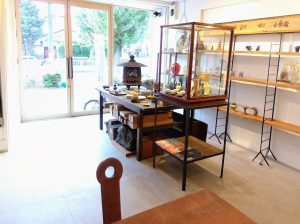紅葉が近づいてまいりました。(愛知県名古屋市千種区姫池通 骨董買取 古美術風光舎)
2025.11.06

通勤途中、リュック、帽子、ウォーキングシューズの方をお見かけしました。今朝は秋晴れの快晴。絶好の行楽日和ですね。どこか紅葉狩りにでもお出かけでしょうか。
TVでは各地で紅葉の見ごろのニュースが入ってきておりますが、皆さまの地域はいかがでしょうか。暑さが長引いたせいもあり、気が付くともう紅葉!?と、季節の変化についていけてませんが、葉の彩にちょっとホッとする季節になってきました。
今年の紅葉は、ウェザーニューズによると、東北~九州は10月中旬にかけて気温の高い日が多くなり、葉の色付きは足踏み状態。平均気温は11月も高めとなる予想ですが、10月下旬になってからは朝晩は冷える日が増えてきているため、今後は天気が周期的に変化し、晴れる日の朝晩は色付きに必要な気温低下が見込めるため、まだ見頃を迎えていない名所では平年並〜平年よりやや遅い見頃になるとのこと。
葉が鮮やかに色付くためには、秋に適度な日差しと雨があり、気温がしっかりと下がることが必要とのことですが、今年は夏の記録的な暑さや多照、少雨の影響で葉焼けしているなど葉の健康状態があまり良好でないところもあるようです。たしかに、家の近くにいちょう並木があるのですが、葉が枯れているような印象もあり、今年は大丈夫かな、なんて心配していたところです。
それにしてもそんな情報ばかりを集めていますと、自分もどこか「紅葉狩り」に出かけたい欲がふつふつと湧いてくるのですが、こうして改めて読んでみますと、「紅葉狩り」って、いったい何を狩るのか…面白い言葉です。
紅葉狩りはもちろん色づいた葉を木から取るという意味ではなく、秋(例年9月~11月ごろ)に山などに行き、美しい紅葉を鑑賞することなのですが、一説によると、紅葉狩りの文化を作ったのは平安時代の貴族と言われております。紅葉狩りは野山まで歩く必要がありますが、身分の高い貴族は自由に出歩るくことはできません。貴族の間では「徒歩は平民のやることだ」と考えられていたため、貴族が出歩く際は牛車などに乗るのが一般的でした。そこであるアイデアが浮かびます。それは「紅葉を見ることを“狩り”に見立てれば、自分の足で歩いても貴族の体裁が保てる」というもので、これがきっかけで“紅葉狩り”という言葉が誕生したとされております。(※諸説あり)
当時の貴族は春には桜を愛で、秋には紅葉狩りを楽しんで和歌を詠んでおりましたので、どうしても紅葉を近くで愛で、一句したためたかったのでしょう。
なお、一般市民が紅葉狩りを本格的に楽しむようになったのは江戸時代とされています。どうやら貴族の変なプライドから生まれた言葉のようではありましたが、後世の一般市民も貴族言葉を使うことには悪い気はしなかった…ということで、そのまま使っていたということでしょうか。
そして令和となりましたこの時代、そんな「紅葉狩り」の本来の意味はどこかへ消え去っております。が、その意味を知りますと、紅葉を背に変なポーズの写真を撮っている場合ではなく、口元を袖のたもとで抑え、顔を隠して一句詠まねばならないような…そんな気分にもなってくるというもの。
ですが、紅葉を楽しむ気持ちは今も昔もみな同じ。「紅葉狩り」の言葉の音だけを拝借いたしまして、今年はどこか紅葉狩りに行って参りたいと思っております。
ではでは、また。(スタッフT)

On my commute, I spotted someone with a backpack, hat, and walking shoes. This morning is a clear, crisp autumn day—perfect for an outing. Perhaps they’re heading out to see the autumn leaves?
TV reports are coming in about peak foliage across various regions. How about where you are? The lingering heat made me realize suddenly—already autumn leaves!? I’m struggling to keep up with the season’s changes, but the colors of the leaves are bringing a bit of relief.
According to Weathernews, this year’s foliage in areas from Tohoku to Kyushu has seen many warm days through mid-October, causing the leaves to stall in their color change. Average temperatures are also expected to remain high into November. However, since late October, cooler mornings and evenings have become more frequent. Going forward, weather is expected to fluctuate cyclically. Clear mornings and evenings should bring the necessary temperature drops for color development. Therefore, spots not yet at peak are expected to reach their prime around the usual time or slightly later than average.
For leaves to turn vividly, autumn needs moderate sunlight and rain, along with a significant drop in temperature. However, this year, due to the record-breaking summer heat, excessive sunshine, and low rainfall, some leaves appear scorched, and the overall health of the foliage isn’t great in some areas. Indeed, there’s a row of ginkgo trees near my house, and the leaves look somewhat withered, making me worry if they’ll be okay this year.
Still, gathering all this information makes me feel a bubbling desire to go out for some “momijigari” myself. But reading about it again, I wonder… what exactly are we ‘hunting’ in “momijigari”? It’s an interesting word.
Of course, “kōyō-gari” doesn’t mean picking the colored leaves from the trees. It refers to going to the mountains or countryside during autumn (typically September to November) to admire the beautiful autumn foliage. One theory suggests the culture of “kōyō-gari” was established by aristocrats during the Heian period. While “kōyō-gari” requires walking to the mountains or fields, high-ranking aristocrats couldn’t freely go out. Among the nobility, walking was considered “something commoners do,” so nobles typically rode in ox-drawn carts when traveling. This led to an idea: “If viewing autumn leaves is likened to ‘hunting,’ then walking on foot could still maintain a noble’s dignity.” This is said to be the origin of the term “momijigari.” (Note: There are various theories.)
Since nobles of the time admired cherry blossoms in spring and enjoyed autumn leaf viewing while composing waka poetry in autumn, they likely felt compelled to admire the autumn leaves up close and compose a verse.
It is said that common citizens began to fully enjoy autumn leaf viewing during the Edo period. While the term seems to have originated from the nobles’ peculiar pride, later commoners apparently didn’t mind using the nobles’ language… so they simply adopted it.
Now, in this Reiwa era, the original meaning of “kōyōgari” has faded away. Yet, knowing its true meaning makes you feel it’s not the time for awkward photos with autumn leaves as a backdrop. Instead, you should cover your mouth with your sleeve, hide your face, and compose a verse… that kind of mood.
Still, the joy of enjoying autumn leaves remains unchanged through the ages. Borrowing only the sound of the phrase “kōyōgari,” I find myself wanting to go somewhere this year to enjoy the autumn leaves.
Well then, until next time. (Staff T)
*******************
ご実家の整理やお片付けなどをされている方のご相談などが多くございます。
お片付けなどくれぐれもご無理のないようになさってくださいませ。
風光舎では古美術品や骨董品の他にも絵画や宝石、趣味のお品など様々なジャンルのものを買受しております。
お片付けをされていて、こういうものでもいいのかしらと迷われているものでも、どうぞお気軽にご相談下さいませ。
また風光舎は、出張買取も強化しております。ご近所はもちろん、愛知県内、岐阜県、三重県その他の県へも出張いたします。
なお、毎月21日の持込鑑定会では無料鑑定・買取・ご相談など、ご予約なしで承っております。
ご近所の皆さま、ご遠方のみなさまも、お気軽にお越しくださいませ。
まずは、お電話お待ちしております。
愛知県名古屋市千種区姫池通
骨董 買取【古美術 風光舎 名古屋店】
TEL052(734)8444
10:00-18:00 OPEN
#出張買取#骨董#古美術#骨董品#絵画#版画#茶道具#刀剣#彫刻

